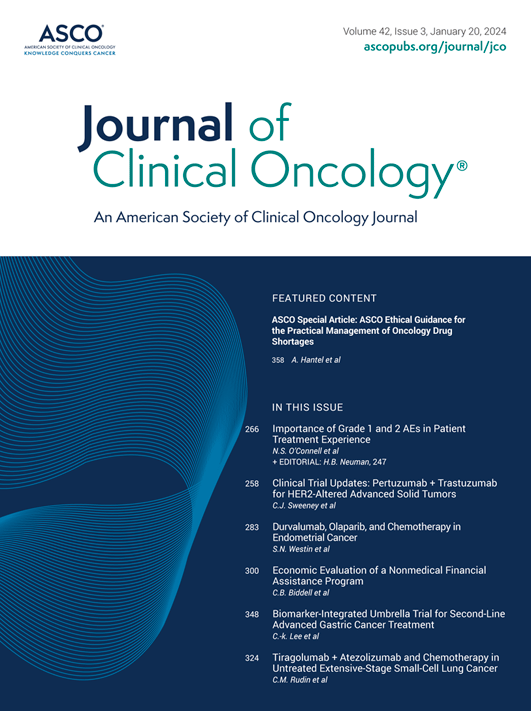基于瘦体质量的奥沙利铂剂量计算对III期结肠癌辅助治疗中神经毒性的影响:II期随机LEANOX试验的结果
IF 42.1
1区 医学
Q1 ONCOLOGY
引用次数: 0
摘要
目的以奥沙利铂为基础的辅助化疗用于III期结肠癌,但可能引起致残性神经毒性。我们之前的研究表明奥沙利铂诱导的周围神经毒性(OIPN)的发生率在奥沙利铂剂量为每公斤瘦体重(LBM) 3.09 mg时更高。这项概念验证、多中心、随机试验评估了基于lbi的奥沙利铂剂量调整是否会降低OIPN (ClinicalTrials.gov编号:NCT03255434)。方法:在切除的III期结肠癌患者中,适合辅助亚叶酸钙、氟尿嘧啶和奥沙利铂化疗,未减少LBM的患者接受基于体表面积(BSA)的奥沙利铂剂量(85 mg/m2,第1组)。LBM减少的患者被随机分配(1:1)接受基于bsa(第2组)或基于LBM的奥沙利铂剂量(3.09 mg/kg LBM,第3组)。主要终点是前6个周期无≥2级OIPN患者的百分比。结果1、2和3组分别有33、64和63例患者入组(中位年龄63岁;男性占52.5%;89.3%东部肿瘤合作组0;pT3 57.5%;pN1 60.6%)。第3组67.2%的患者达到了主要终点,而第2组为42.1% (P = 0.01)。≥2级无oipn存活时间更长(风险比[HR], 0.53 [95% CI, 0.34 ~ 0.84];P = 0.01), OIPN≥2级发病时间较长(P = 0.006),无OIPN≥2级的奥沙利铂累积剂量较高(P = 0.044),奥沙利铂剂量减少较少(P < 0.001)。无复发生存期(HR, 1.05 [95% CI, 0.54 ~ 2.06])和总生存期(OS;HR, 1.20 [95% CI, 0.36 ~ 3.92]),组2和组3相似(中位随访时间为38.6个月)。生活质量问卷化疗诱导的周围神经病变20分在第3组较好。结论:在III期结肠癌的辅助治疗中,使用基于lbm的奥沙利铂剂量可显著降低OIPN,改善生活质量,而不影响无复发生存期和OS。本文章由计算机程序翻译,如有差异,请以英文原文为准。
Impact of Lean Body Mass-Based Oxaliplatin Dose Calculation on Neurotoxicity in Adjuvant Treatment of Stage III Colon Cancer: Results of the Phase II Randomized LEANOX Trial.
PURPOSE
Oxaliplatin-based adjuvant chemotherapy is used for stage III colon cancer, but may induce disabling neurotoxicity. We previously showed that the incidence of oxaliplatin-induced peripheral neurotoxicity (OIPN) is higher for oxaliplatin doses >3.09 mg per kg of lean body mass (LBM). This proof-of-concept, multicenter, randomized trial assessed whether LBM-based oxaliplatin dose adjustment reduces OIPN (ClinicalTrials.gov identifier: NCT03255434).
METHODS
Among the patients with resected stage III colon cancer eligible for adjuvant leucovorin, fluorouracil, and oxaliplatin chemotherapy, those without LBM reduction received body surface area (BSA)-based oxaliplatin doses (85 mg/m2, arm 1). Patients with reduced LBM were randomly assigned (1:1) to receive BSA-based (arm 2) or LBM-based oxaliplatin doses (3.09 mg/kg LBM, arm 3). The primary end point was the percentage of patients without grade ≥2 OIPN in the first six cycles.
RESULTS
In all, 33, 64, and 63 patients were enrolled in arms 1, 2, and 3, respectively (median age, 63 years; 52.5% of men; 89.3% Eastern Cooperative Oncology Group 0; 57.5% pT3; 60.6% pN1). The primary end point was achieved by 67.2% of patients in arm 3 versus 42.1% in arm 2 (P = .01). Longer grade ≥2 OIPN-free survival (hazard ratio [HR], 0.53 [95% CI, 0.34 to 0.84]; P = .01), longer time to grade ≥2 OIPN onset (P = .006), higher cumulative oxaliplatin doses without grade ≥2 OIPN (P = .044), and fewer oxaliplatin dose reductions (P < .001) were reported in arm 3. Relapse-free survival (HR, 1.05 [95% CI, 0.54 to 2.06]) and overall survival (OS; HR, 1.20 [95% CI, 0.36 to 3.92]) were similar in arms 2 and 3 (median follow-up of 38.6 months). Quality of Life Questionnaire Chemotherapy-Induced Peripheral Neuropathy 20 scores were better in arm 3.
CONCLUSION
In adjuvant settings for stage III colon cancer, using an LBM-based oxaliplatin dose significantly reduces OIPN and improves quality of life without affecting relapse-free survival and OS.
求助全文
通过发布文献求助,成功后即可免费获取论文全文。
去求助
来源期刊

Journal of Clinical Oncology
医学-肿瘤学
CiteScore
41.20
自引率
2.20%
发文量
8215
审稿时长
2 months
期刊介绍:
The Journal of Clinical Oncology serves its readers as the single most credible, authoritative resource for disseminating significant clinical oncology research. In print and in electronic format, JCO strives to publish the highest quality articles dedicated to clinical research. Original Reports remain the focus of JCO, but this scientific communication is enhanced by appropriately selected Editorials, Commentaries, Reviews, and other work that relate to the care of patients with cancer.
 求助内容:
求助内容: 应助结果提醒方式:
应助结果提醒方式:


